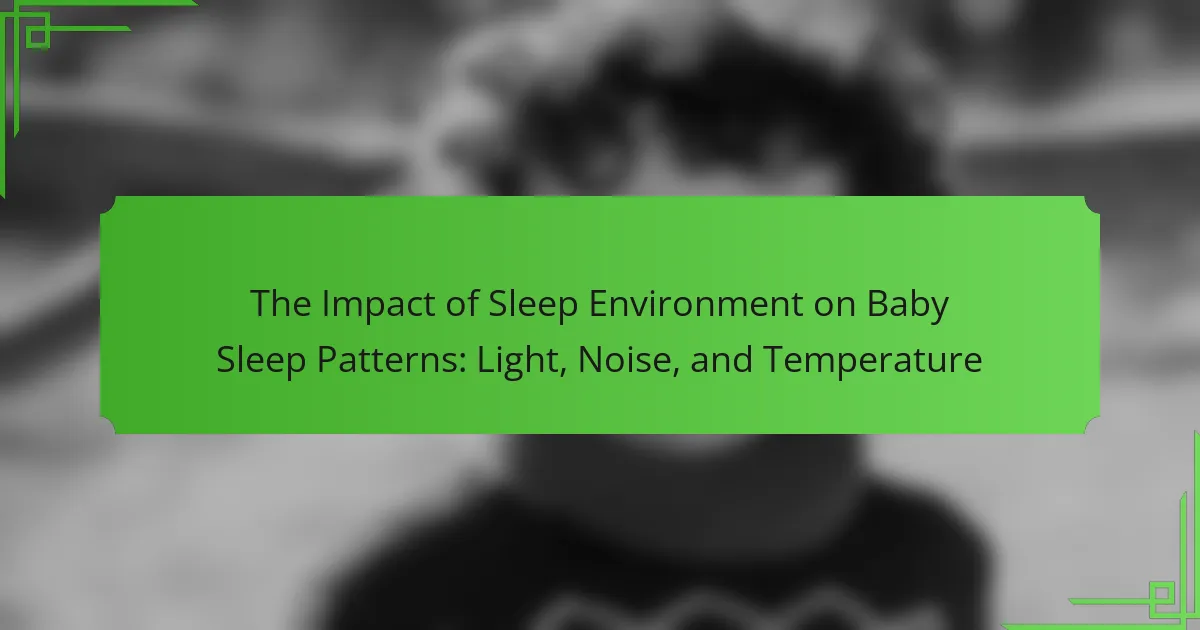The sleep environment significantly influences baby sleep patterns, with light, noise, and temperature being key factors. A dark room enhances melatonin production, promoting longer sleep durations, while excessive light can disrupt circadian rhythms, leading to shorter sleep periods. Noise levels also play a critical role; consistent, soothing sounds can facilitate quicker sleep onset, whereas loud noises may cause awakenings. Maintaining a comfortable temperature between 68°F and 72°F is essential, as extreme temperatures can lead to restlessness and increase the risk of Sudden Infant Death Syndrome (SIDS). This article examines how these environmental factors impact the quality of sleep in infants and offers insights for creating an optimal sleep setting.

What is the Impact of Sleep Environment on Baby Sleep Patterns?
The sleep environment significantly affects baby sleep patterns. Factors such as light, noise, and temperature play crucial roles. A dark room promotes melatonin production, aiding in longer sleep durations. Excessive light can disrupt circadian rhythms, leading to shorter sleep periods. Noise levels can also impact sleep quality. Consistent, soothing sounds may help babies fall asleep faster. Conversely, loud or abrupt noises can cause awakenings. Additionally, maintaining a comfortable temperature is vital. A room that is too hot or too cold can lead to restlessness. Studies indicate that optimal sleep environments correlate with improved sleep quality in infants.
How do light, noise, and temperature affect baby sleep?
Light, noise, and temperature significantly affect baby sleep. Bright light can disrupt melatonin production, making it harder for babies to fall asleep. Research shows that a dark environment promotes better sleep quality. Noise levels can also impact sleep; consistent loud sounds may cause frequent awakenings. Conversely, white noise can help some babies sleep better by masking sudden noises. Temperature plays a crucial role as well; babies sleep best in a cool environment, ideally between 68°F to 72°F. Studies indicate that overheating can lead to restlessness and increased wakefulness. Therefore, managing light, noise, and temperature is essential for optimal baby sleep.
What role does light play in regulating baby sleep cycles?
Light plays a crucial role in regulating baby sleep cycles. It influences the production of melatonin, a hormone that signals sleep. Exposure to natural light during the day helps establish a healthy circadian rhythm. This rhythm controls sleep-wake patterns in infants. Bright light during the day promotes alertness and activity. Conversely, dim light in the evening encourages sleepiness. Research shows that consistent light exposure patterns can improve sleep quality in babies. For instance, a study published in “Pediatrics” by Mindell et al. found that light exposure significantly affects sleep onset and duration in infants.
How does noise influence a baby’s ability to sleep soundly?
Noise negatively influences a baby’s ability to sleep soundly. Exposure to loud or sudden noises can disrupt a baby’s sleep cycle. Babies are sensitive to sound, and even soft noises can wake them. Studies show that consistent noise can lead to fragmented sleep. For instance, a study published in the journal “Pediatrics” found that babies exposed to high noise levels experienced more awakenings. Additionally, white noise can sometimes help mask disruptive sounds, promoting better sleep. Overall, a quiet sleep environment is crucial for a baby’s restful sleep.
What is the ideal temperature for a baby’s sleep environment?
The ideal temperature for a baby’s sleep environment is between 68°F and 72°F (20°C to 22°C). This temperature range helps prevent overheating, which can increase the risk of sudden infant death syndrome (SIDS). Research indicates that maintaining this temperature promotes better sleep quality for infants. The American Academy of Pediatrics recommends keeping the room at this temperature for safe sleep practices.
Why is understanding sleep environment important for parents?
Understanding the sleep environment is crucial for parents because it directly influences their baby’s sleep quality. A conducive sleep environment can enhance the duration and depth of sleep. Factors such as light, noise, and temperature play significant roles in this context. Research shows that a dark, quiet, and comfortably cool room promotes better sleep for infants. For instance, the National Sleep Foundation indicates that optimal room temperature for babies is between 68 to 72 degrees Fahrenheit. Additionally, excessive noise can disrupt sleep cycles, making it harder for babies to fall and stay asleep. Parents who comprehend these elements can create a nurturing sleep space, leading to healthier sleep patterns for their children.
What are the potential consequences of a poor sleep environment?
A poor sleep environment can lead to various negative consequences. It can disrupt sleep quality and duration. This disruption may result in increased irritability and mood swings. Babies may experience difficulty falling asleep or staying asleep. Insufficient sleep can impact cognitive development and learning. Research indicates that noise can elevate stress hormones in infants. Light exposure at night can interfere with melatonin production. An uncomfortable temperature can lead to restlessness and frequent awakenings. Overall, a poor sleep environment can adversely affect a baby’s health and well-being.
How can a positive sleep environment promote better sleep for babies?
A positive sleep environment promotes better sleep for babies by creating conditions that enhance comfort and security. A dark room helps regulate melatonin production, which is crucial for sleep. Maintaining a consistent temperature between 68-72°F (20-22°C) prevents overheating or chilling, both of which can disturb sleep. Reducing noise levels minimizes disruptions, allowing babies to enter deeper sleep stages. Soft, calming sounds or white noise can also aid in soothing infants to sleep. Comfortable bedding and a safe crib setup contribute to a sense of security, further promoting restful sleep. Research indicates that babies in optimized sleep environments show improved sleep duration and quality.

What are the Effects of Light on Baby Sleep Patterns?
Light significantly affects baby sleep patterns. Exposure to light influences the production of melatonin, a hormone that regulates sleep. Bright light can delay sleep onset in infants. This effect is particularly pronounced in the evening when melatonin levels typically rise. Studies show that excessive light exposure at night can lead to shorter sleep duration and increased wakefulness. Conversely, dim lighting during sleep promotes better sleep quality in babies. Research indicates that babies sleep more soundly in darker environments. Therefore, managing light exposure is crucial for optimal baby sleep patterns.
How does exposure to natural light impact baby sleep?
Exposure to natural light positively impacts baby sleep. Natural light helps regulate a baby’s circadian rhythms. Circadian rhythms are the internal processes that affect sleep-wake cycles. Exposure during the day promotes alertness and activity. This leads to improved sleep patterns at night. Research indicates that babies exposed to natural light sleep longer and more soundly. A study published in the journal “Pediatrics” found that infants with more daylight exposure had better sleep outcomes. The presence of natural light also reduces the production of sleep hormones during the day. This reinforces the importance of a light-rich environment for healthy sleep.
What are the benefits of natural light during the day?
Natural light during the day enhances mood and well-being. Exposure to natural light increases serotonin levels, which can improve mood and help alleviate depression. It regulates circadian rhythms, promoting better sleep patterns. Studies show that natural light exposure can lead to increased productivity and focus. Natural light also supports vitamin D synthesis, which is essential for bone health. Furthermore, it can reduce eye strain compared to artificial lighting. Overall, natural light contributes positively to both physical and mental health.
How can artificial light disrupt a baby’s sleep at night?
Artificial light can disrupt a baby’s sleep at night by interfering with their natural circadian rhythms. Exposure to artificial light, especially blue light from screens, can inhibit the production of melatonin, the hormone that regulates sleep. This disruption can lead to difficulty falling asleep and reduced sleep quality. Research indicates that infants exposed to light during nighttime may experience increased wakefulness and shorter sleep durations. Studies show that maintaining a dark sleep environment can promote better sleep patterns in babies.
What types of lighting are best for a baby’s sleep environment?
Soft, dim lighting is best for a baby’s sleep environment. This type of lighting promotes relaxation and helps signal to the baby that it is time to sleep. Nightlights with warm, low-intensity bulbs are ideal. They provide enough illumination for nighttime feedings or diaper changes without disturbing the baby’s sleep. Avoid bright, harsh lights as they can disrupt the baby’s circadian rhythm. Studies show that exposure to bright light before bedtime can interfere with sleep quality. Therefore, using soft lighting aids in creating a calming atmosphere conducive to sleep.
What are the characteristics of sleep-friendly lighting?
Sleep-friendly lighting is characterized by its ability to promote relaxation and minimize disruptions to sleep. It typically features warm color temperatures, ideally between 2700K and 3000K. This range reduces blue light exposure, which can interfere with melatonin production. Additionally, sleep-friendly lighting is dimmable to adjust brightness levels according to the time of day. Soft, ambient lighting is preferred over harsh, direct light. The use of light fixtures that diffuse light helps to create a calming atmosphere. Furthermore, lighting should be used strategically, such as minimizing exposure during nighttime hours. Studies indicate that exposure to appropriate lighting can enhance sleep quality and duration.
How can parents create a calming light environment for bedtime?
Parents can create a calming light environment for bedtime by using soft, warm lighting. This type of light promotes relaxation and signals the body that it is time to wind down. Dimmer switches can be installed to adjust brightness levels. Nightlights with adjustable colors can provide a soothing ambiance. Avoiding harsh, bright lights is essential as they can disrupt melatonin production. Blue light from screens should be minimized before bedtime. Research indicates that warm light can help improve sleep quality in children. A study published in the journal “Sleep Medicine” shows that lower light levels can enhance sleep onset and duration.

How Does Noise Affect Baby Sleep Quality?
Noise negatively affects baby sleep quality. It can lead to increased awakenings and fragmented sleep patterns. Babies are particularly sensitive to sounds during their sleep cycles. Studies show that loud noises can disrupt deep sleep stages. For instance, research published in the journal “Pediatrics” indicates that noise exposure is linked to sleep disturbances in infants. Continuous background noise can prevent babies from entering restorative sleep phases. This results in poorer overall sleep quality and increased fussiness during waking hours. Reducing noise in a baby’s sleep environment is crucial for better sleep outcomes.
What types of noise are most disruptive to baby sleep?
Loud and sudden noises are most disruptive to baby sleep. Examples include sirens, alarms, and thunder. These sounds can startle babies and cause them to wake up. Continuous noises like traffic or loud conversations can also interfere with sleep quality. Research indicates that babies are sensitive to noise levels. A study published in the journal “Pediatrics” shows that excessive noise can lead to sleep disturbances in infants. Maintaining a quiet environment is essential for promoting better sleep in babies.
How does white noise compare to other sounds for soothing babies?
White noise is often more effective for soothing babies compared to other sounds. It mimics the sounds heard in the womb, providing a familiar auditory environment. Research shows that white noise can help babies fall asleep faster and stay asleep longer. A study published in the journal “Pediatrics” found that 80% of infants fell asleep within five minutes when exposed to white noise. In contrast, other sounds, such as lullabies or nature sounds, may not have the same calming effect. White noise creates a consistent sound backdrop, which can mask sudden noises that might wake a baby. This masking effect is less pronounced with other sound types. Overall, white noise is a preferred choice for many parents seeking to soothe their babies effectively.
What strategies can parents use to minimize disruptive noise?
Parents can minimize disruptive noise by creating a quiet sleep environment. They can use white noise machines to mask background sounds. Soundproofing windows and doors can reduce external noise. Heavy curtains can also help dampen sound. Establishing a consistent bedtime routine encourages a calm atmosphere. Limiting loud activities during sleep hours is essential. Additionally, using soft furnishings can absorb sound. These strategies contribute to a more conducive sleep environment for babies.
How can sound machines aid in improving baby sleep?
Sound machines can significantly aid in improving baby sleep by creating a consistent auditory environment. They produce white noise or soothing sounds that mask disruptive noises. This helps to drown out sudden sounds that may wake a baby. Studies show that continuous sound can promote longer sleep durations. For instance, research published in the journal “Pediatrics” indicates that white noise can help infants fall asleep faster. The rhythmic sounds from these machines can mimic the sounds heard in the womb. This familiarity can be comforting and calming for babies. Overall, sound machines can enhance the quality of sleep by reducing disturbances and providing a soothing backdrop.
What features should parents look for in a sound machine?
Parents should look for several key features in a sound machine. First, adjustable volume levels are essential for customizing sound intensity. Next, a variety of sound options, such as white noise, nature sounds, and lullabies, can cater to different preferences. A timer function allows parents to set the machine to turn off after a specific duration. Portability is also important, enabling easy travel and use in different locations. Additionally, a night light feature can provide comfort and visibility during nighttime. Finally, ease of use and intuitive controls help parents operate the device effortlessly. These features collectively enhance the sleep environment, promoting better sleep patterns for babies.
How can sound machines be used effectively in a baby’s routine?
Sound machines can be used effectively in a baby’s routine by creating a consistent auditory environment. They help mask disruptive noises that may wake the baby. White noise or gentle lullabies can promote relaxation and signal bedtime. Using the machine at the same volume each night establishes a sleep association. Gradually lowering the volume can ease the baby into deeper sleep stages. Research shows that consistent sound exposure can improve sleep duration in infants. A study published in the Journal of Pediatric Psychology found that babies exposed to white noise fell asleep faster and slept longer.

What is the Optimal Temperature for Baby Sleep?
The optimal temperature for baby sleep is between 68°F and 72°F (20°C to 22°C). This range helps to maintain a comfortable sleep environment. Babies are sensitive to temperature changes. An environment that is too hot or too cold can disrupt their sleep. Research indicates that maintaining this temperature range reduces the risk of overheating. Overheating is linked to an increased risk of Sudden Infant Death Syndrome (SIDS). Parents should monitor room temperature using a thermometer. Adjusting clothing and bedding can help maintain the ideal temperature.
How does temperature impact a baby’s comfort during sleep?
Temperature significantly impacts a baby’s comfort during sleep. Babies are sensitive to temperature variations. An ideal sleep environment for infants is typically between 68°F and 72°F (20°C to 22°C). Temperatures outside this range can lead to discomfort. If it’s too hot, babies may experience restlessness or difficulty falling asleep. Conversely, if it’s too cold, they may wake up frequently or cry. Research indicates that overheating is linked to an increased risk of Sudden Infant Death Syndrome (SIDS). Therefore, maintaining a stable, moderate temperature is crucial for safe and restful sleep for infants.
What range of temperatures is considered safe for baby sleep?
The safe range of temperatures for baby sleep is between 68°F and 72°F (20°C to 22°C). Maintaining this temperature helps prevent overheating. Overheating can increase the risk of sudden infant death syndrome (SIDS). According to the American Academy of Pediatrics, a comfortable sleep environment is crucial for infant safety. Parents should regularly check the baby’s temperature. Adjust bedding and clothing as needed to maintain the ideal range. Using a room thermometer can help ensure the temperature stays within this range.
How can parents adjust the sleep environment for seasonal changes?
Parents can adjust the sleep environment for seasonal changes by modifying temperature, light, and noise levels. In warmer months, parents should ensure the room is cool, ideally between 68-72°F. They can use fans or air conditioning to maintain comfort. In colder months, parents should keep the room warm, using appropriate bedding and clothing.
Light control is also essential. During longer summer days, parents can use blackout curtains to block excess sunlight. In winter, natural light exposure in the morning can help regulate circadian rhythms.
Noise levels can be managed with white noise machines or soft music to create a calming atmosphere. These adjustments help create a consistent sleep environment, promoting better sleep quality for babies.
What are common misconceptions about baby sleep temperature?
Common misconceptions about baby sleep temperature include the belief that warmer temperatures are always better for babies. Many think that bundling a baby in heavy blankets prevents them from waking up. However, overheating can increase the risk of Sudden Infant Death Syndrome (SIDS). Another misconception is that babies need to be kept at a constant warm temperature throughout the night. Research indicates that a room temperature between 68°F and 72°F is ideal for safe sleep. Parents often underestimate how sensitive babies are to temperature changes. Babies can regulate their body temperature effectively when dressed appropriately. It’s also a myth that all babies prefer the same sleep temperature. Each baby’s comfort level can vary based on individual preferences and environmental factors.
How can overheating affect a baby’s sleep quality?
Overheating can significantly disrupt a baby’s sleep quality. When a baby is too hot, it can lead to discomfort and restlessness during sleep. Research indicates that elevated temperatures can result in shorter sleep duration and more frequent awakenings. A study published in the journal “Pediatrics” found that infants sleeping in overly warm environments experienced increased wakefulness. Additionally, overheating is associated with a higher risk of Sudden Infant Death Syndrome (SIDS). Maintaining a comfortable sleep temperature is crucial for promoting better sleep quality in babies.
What are the signs that a baby is too cold or too hot during sleep?
Signs that a baby is too cold during sleep include cold hands and feet, a cool abdomen, and shivering. A baby who is too cold may also have a pale appearance. Signs that a baby is too hot during sleep include sweating, flushed skin, and rapid breathing. A baby who is too hot may be fussy and have a warm forehead. Monitoring these signs can help ensure the baby sleeps comfortably.
What are Practical Tips for Creating an Ideal Sleep Environment for Babies?
To create an ideal sleep environment for babies, ensure the room is dark, quiet, and at a comfortable temperature. Darkness promotes melatonin production, aiding sleep. Use blackout curtains to block out light. A white noise machine can mask disruptive sounds, helping babies sleep longer. The ideal room temperature for infants is between 68°F and 72°F (20°C to 22°C). This range prevents overheating and promotes comfort. A firm mattress with a fitted sheet is essential for safety. Avoid soft bedding, including pillows and blankets, to reduce the risk of suffocation. Establishing a consistent bedtime routine signals to the baby that it is time to sleep. These practices contribute to better sleep patterns and overall well-being for infants.
How can parents effectively combine light, noise, and temperature adjustments?
Parents can effectively combine light, noise, and temperature adjustments to create an optimal sleep environment for their babies. They should maintain a dark room during sleep hours to promote melatonin production. Using blackout curtains can help block external light. Parents can also utilize white noise machines to mask disruptive sounds. This consistent background noise can soothe babies and help them sleep better.
The ideal room temperature for infants is between 68°F and 72°F. Parents should monitor the temperature with a thermometer to ensure comfort. Combining these elements creates a calming atmosphere. Research shows that a well-adjusted sleep environment significantly improves infant sleep quality.
What best practices should parents follow for optimizing baby sleep conditions?
To optimize baby sleep conditions, parents should maintain a dark, quiet, and cool sleep environment. Darkness promotes melatonin production, which is essential for sleep. Using blackout curtains can effectively block out light. White noise machines can mask disruptive sounds, aiding in longer sleep durations. The ideal room temperature for babies is between 68°F and 72°F (20°C to 22°C). This temperature range helps prevent overheating. Establishing a consistent bedtime routine signals to the baby that it is time to sleep. Research indicates that infants who follow routines sleep better and have improved overall sleep quality.
The main entity of this article is the sleep environment and its impact on baby sleep patterns, specifically focusing on the attributes of light, noise, and temperature. The article outlines how these factors influence sleep quality and duration in infants, emphasizing the importance of a dark, quiet, and comfortably cool room for optimal sleep. It discusses the effects of light on melatonin production, how noise levels can disrupt sleep cycles, and the ideal temperature range for safe infant sleep. Additionally, it addresses common misconceptions and provides practical tips for parents to create an ideal sleep environment for their babies.
